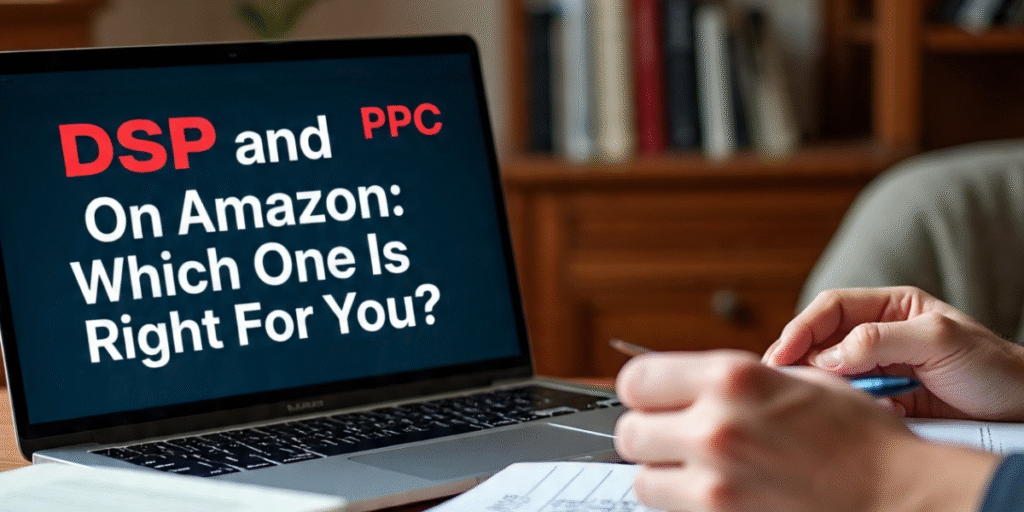In today’s competitive digital marketplace, advertising on Amazon is no longer optional; it’s a necessity. As more brands flood the platform and organic visibility becomes harder to achieve, sellers must turn to paid advertising to maintain relevance, generate traffic, and drive conversions. Two of the most powerful advertising solutions Amazon offers are DSP (Demand-Side Platform) and PPC (Pay-Per-Click). While both can be highly effective, understanding the differences and knowing when to use each is crucial to making smart advertising investments in 2025.
Amazon PPC has long been the go-to strategy for sellers looking to boost visibility within Amazon’s internal search ecosystem. It targets users who are actively searching for products with the intent to purchase. On the other hand, Amazon DSP is a programmatic display and video advertising platform that allows you to reach audiences both on and off Amazon, even if they’re not actively searching at the moment. This makes it ideal for brand awareness and retargeting campaigns.
So, how do you decide whether to use DSP or PPC, or both? In this comprehensive guide, we’ll compare the platforms in depth, explore how they fit into your brand strategy, and help you determine which one is right for your goals in 2025.
What Is Amazon PPC?
Amazon PPC is the advertising platform most sellers are already familiar with. It allows you to bid on keywords so your products appear in sponsored placements on Amazon’s search results pages, product detail pages, and other related placements. It’s a cost-per-click model, meaning you only pay when a user clicks on your ad.
The main types of PPC campaigns include Sponsored Products, Sponsored Brands, and Sponsored Display. These are highly targeted and typically aimed at driving conversions from high-intent shoppers already browsing Amazon.
PPC works best for sellers who want to boost product visibility, improve rankings, and directly influence sales performance. It is essential for product launches, competitive categories, and increasing market share within specific niches.
What Is Amazon DSP?
Amazon DSP is a demand-side platform that allows advertisers to programmatically buy display, video, and audio ads both on Amazon and across a wide range of third-party websites and apps. Unlike PPC, DSP is not confined to Amazon’s marketplace. It uses Amazon’s massive trove of customer data to serve relevant ads based on behavior, demographics, and purchase history.
DSP ads can appear on IMDb, Fire TV, Twitch, mobile apps, and publisher networks. They are designed for broader marketing goals like brand awareness, retargeting, and audience expansion.
What makes DSP so powerful in 2025 is its ability to target shoppers who have viewed your product but didn’t buy, users who have bought from your competitors, or customers who fit your ideal profile but haven’t yet been exposed to your brand. This makes DSP a long-term growth lever rather than a short-term sales tool.
Key Differences Between DSP and PPC
While both DSP and PPC are effective tools, they serve different purposes. Amazon PPC is ideal for targeting high-intent shoppers inside the marketplace. These users are actively searching for products, so ads appear based on keyword relevance. It’s direct, measurable, and conversion-focused.
In contrast, Amazon DSP is designed to build awareness, drive interest, and retarget audiences throughout the buyer journey. It’s not limited to the Amazon website and doesn’t require users to be actively shopping. DSP is particularly effective for higher-priced items, recurring purchases, or when trying to establish a brand presence across multiple platforms.
The budget structure also differs. PPC gives you full control of spend and bids at a granular level. DSP often requires a minimum spend threshold and is usually managed by Amazon or a certified DSP partner, especially for self-service access. This makes PPC more accessible for small sellers, while DSP is typically used by established brands ready to scale.
How Amazon PPC Helps Sellers Grow
For sellers focused on immediate returns, Amazon PPC is still the most reliable method. It offers real-time bidding, keyword-level control, and a direct correlation between clicks and conversions. You can optimize campaigns based on performance, target exact or broad match keywords, and adjust bids daily to improve your advertising cost of sales.
PPC also plays a crucial role in organic ranking. Products that perform well in Sponsored campaigns often gain higher positions in search results, leading to a flywheel effect. Increased visibility results in more sales, which further boosts rankings.
Amazon PPC is essential for launching new products in 2025. With competition fiercer than ever, achieving visibility during the first few weeks can mean the difference between success and obscurity. By using strategic keyword targeting and A/B testing ads, sellers can identify which terms convert best and refine their approach.
The Strategic Role of DSP in Brand Building
While PPC focuses on converting intent-driven traffic, DSP builds brand exposure across the broader digital ecosystem. In 2025, consumer behavior is more fragmented, and many shoppers discover brands long before they make a purchase. DSP fills that gap.
It allows you to show your ads to audiences who have searched for related items, viewed your competitors, or fall within a demographic profile that aligns with your customer base. This advanced targeting is possible because Amazon leverages its rich first-party data, something most third-party platforms can’t match.
DSP is especially valuable for retargeting. Many shoppers visit product pages but don’t convert. DSP brings them back through tailored messaging and creative visuals, increasing the chances of conversion later. For high-ticket or niche items, this kind of persistence pays off.
When to Use Amazon PPC
Amazon PPC is ideal for any seller who needs to drive immediate sales. It’s particularly effective for:
Launching new products and gaining quick visibility
Competing in saturated markets where ranking for top keywords is difficult
Promoting deals, discounts, or seasonal campaigns
Testing keyword performance before scaling with larger budgets
Sellers with tight budgets will find PPC to be more flexible and easier to manage internally. It allows for agile decision-making, real-time optimization, and clear attribution of return on ad spend.
When to Use Amazon DSP
Amazon DSP is best suited for brands that want to scale visibility and control how their brand is presented across the web. It’s highly effective for:
Retargeting shoppers who have not converted
Building top-of-funnel awareness for new or premium products
Running cross-channel campaigns that integrate display, video, and audio
Establishing a long-term presence in highly competitive categories
Brands with larger advertising budgets and a strong understanding of their ideal customer profile can use DSP to deepen customer engagement. It works well alongside PPC to create a multi-layered advertising funnel.
Can You Use Both PPC and DSP Together?
Absolutely. Combining PPC and DSP is one of the most effective ways to build a comprehensive Amazon advertising strategy in 2025. PPC captures the low-hanging fruit for those ready to buy. DSP nurtures the rest, ensuring your brand stays top of mind until they’re ready to convert.
For example, you might use DSP to build brand awareness with lifestyle videos and display ads targeting competitor audiences. Then, you use PPC to retarget those same users with Sponsored Product ads when they search Amazon later. The synergy between both platforms increases your total reach, engagement, and profitability.
When used together, PPC and DSP create a full-funnel strategy that attracts, educates, and converts buyers at every stage of their journey. This approach can significantly increase customer lifetime value and brand loyalty.
Measuring Success on PPC vs. DSP
Success metrics differ between Amazon PPC and DSP. With PPC, the focus is often on conversion rate, cost per click, and advertising cost of sales. It’s about performance and efficiency. You want to know exactly how much you’re spending and how much revenue is being generated as a result.
DSP, on the other hand, tracks impressions, view-through rate, engagement, and lift in brand searches. Since it’s more focused on visibility and influence, the path to conversion may be longer. That doesn’t make it less effective—it simply requires a different way of measuring ROI.
In 2025, advanced attribution tools will allow sellers to see how both platforms contribute to the customer journey. Multi-touch tracking provides a fuller picture of how awareness and performance campaigns work together to drive results.
Common Mistakes to Avoid
One of the most common mistakes sellers make is expecting DSP to behave like PPC. These are fundamentally different tools and should be used with distinct strategies. Measuring DSP with conversion-only metrics can lead to premature decisions about its effectiveness.
Another mistake is underutilizing audience data. DSP’s greatest strength lies in its ability to target audiences based on behavior and purchase history. Ignoring this data or using generic segments reduces the effectiveness of your campaigns.
Likewise, some sellers jump into DSP without sufficient budget or experience. It’s a powerful tool, but one that requires planning, creative assets, and patience. Make sure your business is ready before scaling with DSP.
Choosing the Right Platform for Your Goals
The right advertising platform depends on your current stage, budget, and business objectives. New sellers or those with limited resources should start with Amazon PPC to generate traction and optimize for conversions. It’s a lower barrier to entry, and results can be measured more directly.
Established brands with long-term goals and larger budgets should consider integrating Amazon DSP. It’s particularly useful if you’re looking to build brand equity, run retargeting campaigns, and extend your reach outside the Amazon ecosystem.
Ultimately, the most successful sellers in 2025 won’t choose between PPC or DSP; they’ll master both. By combining immediate sales performance with long-term brand growth, you build a resilient and scalable Amazon business.
Conclusion
In 2025, winning on Amazon requires more than just great products; it demands smart advertising. While Amazon PPC offers quick wins and direct sales, DSP allows for expansive reach and strategic growth. Each platform plays a unique role, and when used together, they create a powerful, full-funnel strategy that builds brand authority and drives conversions.
If you’re unsure which platform is right for your business, our team can help you design a data-driven advertising roadmap. Reach out to us today and let Amazon FBA Agency guide you toward smarter growth with PPC, DSP, and beyond.
Frequently Asked Questions
What is the main difference between DSP and PPC on Amazon?
PPC is a cost-per-click advertising model focused on Amazon search results and product placements. DSP uses programmatic ads to target users across the internet and Amazon’s own properties based on behavioral data.
Is Amazon DSP better for big brands?
Yes, DSP is typically more effective for established brands with larger budgets. It’s ideal for scaling awareness, retargeting, and expanding beyond the Amazon platform.
Can small sellers use Amazon DSP?
It’s possible, but DSP usually has a higher budget threshold and requires more planning. Most small sellers start with PPC and scale into DSP as their brand and budget grow.
Do DSP ads show on Amazon?
Yes, DSP ads can appear on Amazon’s site and app, but they also run on external networks like Fire TV, IMDb, and thousands of third-party websites.
Should I run both PPC and DSP?
Running both PPC and DSP provides a balanced strategy. PPC captures high-intent shoppers while DSP increases brand awareness and brings shoppers back through retargeting.




